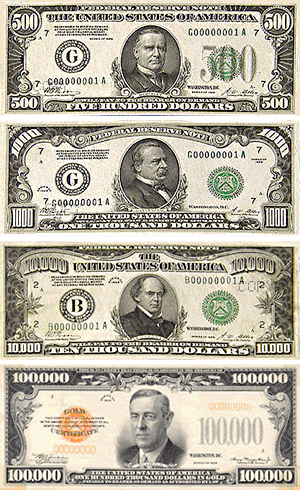|
"Making Cents"
The Signal
Saturday, April 14, 2007
| M |
Well, not only did we have $500 and $1,000 bills in use until some 40 to 50 years ago; I recall — like many others who visited Las Vegas years ago — seeing the fabulous "Million Dollar Horseshoe" on Fremont Street where the Golden Horseshoe Casino featured one hundred $10,000 bills. The display was taken down and one of those bills sold at auction a year or so ago for more than $200,000.
Getting back to the "smaller" bills — the $500 and $1,000: In 1969, not only had the Treasury stopped printing these bills some 20 years earlier, but now it also decided to destroy all that were redeemed. Today, most coin dealers would pay at least 10 percent over face value for a circulated $500 or $1,000 bill.
The first $500 bill was issued in 1862 in the large format (as were all notes before 1929) featuring Albert Gallatin. The next series, in 1869, featured John Quincy Adams. The series from 1874-80 featured Major Gen. Joseph King Mansfield, who died in the battle of Antietam. After several others series, the small-sized notes of 1928 and 1934 featured President William McKinley.
All of the previous issues today are either very rare or unique. These small-sized notes actually saw considerable use in the days before credit cards, and where many small businesses operated on a cash-and-carry basis.
As a small boy in the 1930s, I accompanied Mr. Porter of Porterıs Pickles in Brooklyn to the wholesale market on Canal Street to buy several bushels of cucumbers for pickling. He paid with a $500 bill. I was very impressed and have regarded Mr. Porter a millionaire ever since.
The $1,000 bill also made its entrance in 1862, featuring a portrait of Robert Morris. Several series of portraits were used on the large-sized notes until the small-sized notes started in 1928 with President Grover Cleveland. The two issues of the Cleveland series were 1928 and 1934. They were printed until the early 1940s and circulated until 1969 — although very few ever saw use after World War II.
Since the largest bill in use today, the $100, is certainly not what it was back in the 1930s, it may be time to reintroduce the big bills again — namely the $500 and $1,000.
Reasons: Since the Treasury ships millions of dollars every week in $100 bills to European banks in payment for foreign oil — the Arab countries prefer European banks to their own — the shipments could be reduced in bulk by 80 percent by using $500 bills instead of $100, or even 90 percent by using $1,000 bills.
Next, the $1 bill will need to be phased out and replaced by circulating dollar coins. That would leave more than 50 percent of the Bureau of Engraving and Printing, with no work for half its staff — since more than half of their output today is the $1 bill. They can be put to good work making $500 and $1,000 bills.
Finally, we must recognize that even a low rate of inflation is making our larger bills — the $50 and $100 — less valuable than they were decades ago. In other words, tomorrowıs $500 bill would be equal to todayıs $100 bill, in buying power.
Perhaps with inflation at a higher rate than today, the idea of manufacturing the really big bills — the $5,000 and $10,000 — may become a reality.
Dr. Sol Taylor of Sherman Oaks is president of the Society of Lincoln Cent Collectors and author of The Standard Guide to the Lincoln Cent. Click here for ordering information.
©2007, THE SIGNAL · ALL RIGHTS RESERVED.

![[Most Recent Quotes from www.kitco.com]](http://www.kitconet.com/images/quotes_special.gif)

